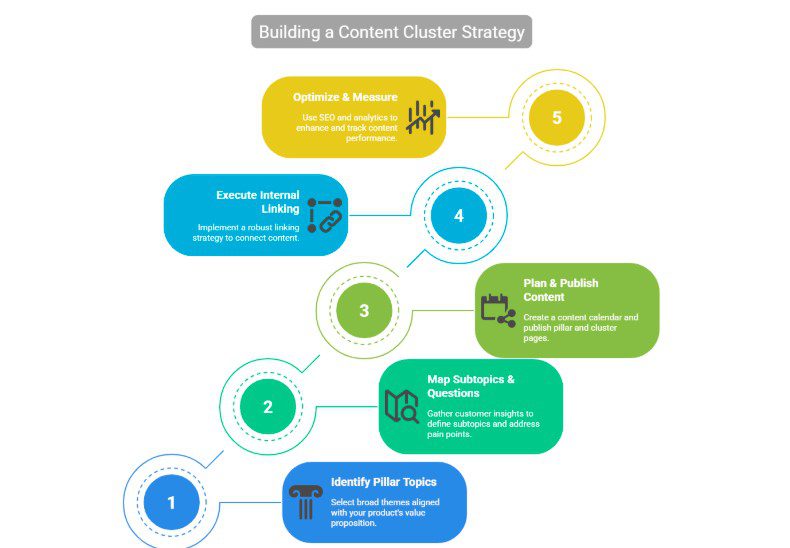In the competitive SaaS landscape, distinguishing your brand requires more than just offering a superior product—it necessitates establishing yourself as the authoritative voice that prospects and customers trust above all others. This is where topical authority becomes your strategic advantage.
What Is Topical Authority?
Topical authority refers to the perception by both search engines and audiences that your brand possesses deep, consistent expertise in a specific subject area. When your SaaS brand consistently publishes insightful, accurate content around particular topics in your niche, you signal to both Google’s algorithms and your target audience that you truly understand their world. It’s the difference between being seen as just another vendor and being recognized as the industry expert who genuinely gets it.
Why Topical Authority is a Game-Changer for SaaS Companies
In the competitive world of SaaS, topical authority is more than just a buzzword—it’s a proven driver of business results. When potential customers search online for solutions to challenges like workflow automation, team collaboration, or productivity optimization, they naturally gravitate toward brands that consistently share in-depth, valuable content.
If your SaaS company has been publishing educational blog posts, case studies, and industry insights around these topics, you’re already building trust before a sales conversation even begins. This trust can significantly shorten sales cycles and reduce the need for extensive persuasion—prospects come to you already convinced of your expertise.
The Compound Power of Content in SaaS Marketing
Topical authority builds over time. Every high-quality article, guide, or thought leadership piece contributes to a growing content ecosystem that showcases your deep understanding of your industry. For example, a project management SaaS platform that regularly publishes expert content on remote work best practices, workflow efficiency, and team communication strategies doesn’t just improve its SEO rankings—it becomes the go-to brand in the minds of potential buyers. To support this, developing a well-structured topical map for SEO can help ensure your content strategy systematically covers the themes your audience and search engines care about most.
Building Topical Authority: A Strategic, Long-Term Investment
Establishing this kind of authority requires a focused, strategic approach. It means:
- Avoiding distractions from irrelevant or trending topics.
- Doubling down on the issues that matter most to your ideal customer personas.
- Creating content that answers FAQs from your sales team and support tickets.
- Sharing unique insights that reflect your deep understanding of the market.
This isn’t about quick wins—it’s about owning your niche and becoming a trusted voice in your space.
For SaaS marketers, having a clearly defined content strategy ensures that every piece contributes to long-term topical authority instead of scattered efforts. This isn’t about quick wins—it’s about owning your niche and becoming a trusted voice in your space.
From Search Visibility to Market Influence
The benefits of topical authority go beyond just higher search rankings. When your brand consistently leads conversations on key industry topics, you start to shape how the market thinks. You influence the terminology prospects use, the solutions they prioritize, and the way they evaluate vendors.
In other words, you’re not just participating in the market—you’re helping define it.
Understanding Semantic SEO and Its Relevance
Semantic SEO focuses on the meaning behind search queries rather than just matching specific keywords. When mapping out all the related concepts around a core topic—say, “team collaboration software”—a free idea generator can surface adjacent questions and subtopics you might otherwise overlook, from “best integrations for remote teams” to “measuring collaboration ROI.”
For SaaS companies, this shift is particularly powerful because customers rarely search using your product’s technical terminology. A marketing manager looking for lead scoring software might search for “how to prioritize sales leads” or “identifying hot prospects automatically.” Semantic SEO helps you connect these real-world problems with your solutions, creating pathways for discovery that traditional keyword targeting would miss.
Search engines reward this approach because semantic optimization typically results in more comprehensive, useful content. Instead of creating thin pages targeting individual keywords, you develop rich resources that thoroughly explore topics and their related concepts. This depth signals expertise and value, two factors that heavily influence modern search rankings.

Key Elements of Building Topical Authority
Building genuine topical authority isn’t about publishing random blog posts and hoping for the best. Instead, it requires a methodical strategy that establishes your brand as the go-to expert in your field. Let’s explore the essential elements that transform scattered content into a powerful authority-building engine.
Choose Your Domain Strategically
The foundation of topical authority begins with selecting your specific area of expertise. Think of this as claiming your territory in the vast landscape of online knowledge. For SaaS companies, this domain should connect directly to your product’s core value while being expansive enough to support ongoing content creation.
Consider a customer relationship management platform as an example. Rather than trying to cover all aspects of business software, they might focus specifically on sales enablement, customer retention strategies, or revenue operations. Here are some specific domain examples that demonstrate this focused approach:
- HubSpot’s Inbound Marketing Focus: Instead of covering all marketing topics, HubSpot built authority around inbound methodology, creating thousands of pieces covering lead generation, content marketing funnels, and buyer personas
- Salesforce’s Customer Success Domain: Rather than general business advice, they focus on customer lifecycle management, renewal strategies, and expansion revenue tactics
- Slack’s Team Collaboration Territory: They’ve established expertise specifically around remote work productivity, team communication patterns, and workplace culture transformation
The strategic advantage comes from choosing territories where your product knowledge provides genuine insights that competitors cannot easily replicate.
This focused approach serves two critical purposes. First, it helps search engines understand exactly what you’re an expert in, making it easier for them to recommend your content to relevant searchers. Second, it creates clarity for your audience about when and why they should turn to you for answers.
Maintain Consistent Publishing Schedules
Consistency becomes your most powerful tool in building authority over time. Publishing sporadically or jumping between unrelated topics creates confusion for both search engines and your audience about your true areas of expertise.
Successful SaaS brands typically establish a weekly publishing rhythm, creating a steady stream of valuable insights within their chosen domain. Consider these content consistency examples from industry leaders:
- Buffer’s Social Media Content Calendar: They publish 2-3 articles weekly, all focused on social media marketing, audience engagement, and content strategy rather than jumping between unrelated business topics
- Intercom’s Customer Communication Focus: Their blog maintains consistent weekly publishing around customer support, conversational marketing, and user onboarding best practices
- Zoom’s Remote Work Content Strategy: Even before the pandemic, they consistently published content about video conferencing best practices, remote team management, and virtual meeting optimization
This regular cadence signals to search engines that your site is actively maintained and continuously adding fresh perspectives to your topic area.
Think of consistency as compound interest for content marketing. Each new piece builds upon the authority established by previous articles, creating momentum that becomes increasingly difficult for competitors to match. The key lies in maintaining this rhythm even when immediate results aren’t visible, understanding that authority builds gradually through sustained effort.
Create Content with Genuine Depth
Surface-level articles that could apply to any industry will never establish true expertise. Real topical authority requires content that demonstrates intimate knowledge of your customers’ specific challenges, regulatory requirements, industry benchmarks, and operational realities.
This means investing time in comprehensive guides that may take weeks to research properly, or developing case studies that reveal proprietary insights from your customer base. The goal is creating content that only someone with deep industry experience could produce.
Compare these two content approaches to understand the difference:
Generic Content Example:
- “10 Tips for Better Customer Service” – This could be written by anyone in any industry and offers no unique insights
Authority-Building Content Examples:
- Specific and Data-Driven: “How SaaS Companies Can Reduce Churn by 23% Through Predictive Customer Health Scoring” – Shows precise metrics and industry-specific knowledge
- Process-Focused: “The Complete Guide to Implementing Customer Success Automation for B2B SaaS Platforms” – Demonstrates deep operational understanding
- Proprietary Insights: “What 50,000 Customer Support Tickets Taught Us About Reducing Time-to-Resolution by 40%” – Uses internal data that competitors cannot replicate
The authority-building examples demonstrate specific knowledge and provide actionable insights that readers cannot find elsewhere.
Build an Interconnected Content Library
As your content library grows, the connections between different pieces become increasingly important for establishing authority. Each article should naturally link to related content, creating a comprehensive web of knowledge that keeps readers engaged while signaling to search engines that you’ve thoroughly covered your topic area.
This internal linking strategy serves multiple purposes and requires thoughtful planning to execute effectively. Here are the key benefits and implementation approaches:
Authority Distribution Benefits:
- Link Equity Flow: When one of your articles gains backlinks and authority, internal links help spread that authority to other related pieces in your content library —helping maximize the SEO impact of earned backlinks, especially if you’re executing a white hat link-building strategy.
- Topic Clustering: Search engines can better understand the breadth of your expertise when they see how thoroughly you’ve covered interconnected subtopics.
- User Journey Optimization: Readers who find value in one article can easily discover related content that addresses their adjacent questions or concerns.
Strategic Internal Linking Examples:
- Pillar Page Strategy: Create comprehensive cornerstone articles that link out to more specific subtopic pages (similar to a pillar cluster content strategy that improves both SEO and user experience).
- Content Series Connections: Link sequential pieces in a logical learning progression, such as connecting “Setting Up Customer Health Scores” to “Acting on Health Score Alerts” to “Measuring Health Score ROI”.
- Contextual Cross-References: Naturally mention and link to related concepts when they support your current point, similar to how academic papers cite supporting research.
Consider how Wikipedia maintains its authority partly through its extensive internal linking system. Each article connects to related topics, creating a sense that the platform has comprehensive coverage of interconnected subjects. Your content strategy should mirror this approach within your specific domain.
Engage Actively with Your Audience
Topical authority extends beyond the content you publish to include how you interact with your community. Active engagement creates multiple touchpoints where your expertise becomes visible and valuable to others. Here are the key engagement strategies that reinforce your authority:
Direct Community Interaction:
- Thoughtful Comment Responses: Instead of generic “thanks for reading” replies, provide additional insights, answer follow-up questions, or share related resources that extend the conversation.
- Industry Forum Participation: Contribute valuable answers on platforms like Reddit, Quora, or industry-specific communities where your target audience asks questions.
- Social Media Thought Leadership: Share insights, respond to industry discussions, and provide commentary on trends within your expertise area—an essential part of building personal branding through thought leadership that drives long-term authority.
Content Amplification Activities:
- Speaking Engagements: Reference your published content during webinars, conference presentations, or podcast interviews to demonstrate the depth of your research. Using a reliable video conference system ensures a professional experience, allowing you to engage with your audience effectively and share supporting visuals or documents in real time.
- Guest Contributions: Write for industry publications or appear on podcasts, always connecting back to your core content library when relevant.
- Collaborative Content: Partner with other experts for co-authored pieces, interviews, or research studies that cross-reference your existing authority-building content.
Practical Examples of Authority-Building Engagement:
- Drift’s Conversational Marketing Leadership: Their team consistently participates in marketing discussions across LinkedIn, Twitter, and industry events, always tying back to their expertise in chatbots and conversational sales
- Ahrefs’ SEO Community Involvement: They actively answer technical SEO questions in forums and social media, often linking to their comprehensive guides and original research
- Gong’s Revenue Intelligence Participation: Their executives regularly contribute to sales methodology discussions, referencing their platform’s conversation analysis data to support broader industry insights
This engagement creates social proof that reinforces the authority signals you’re sending through your content. When real people consistently turn to you for insights and share your work within their networks, it validates your expertise in ways that purely algorithmic signals cannot match.
The combination of high-quality content and genuine community engagement creates a reinforcing cycle. Better content attracts more engaged readers, whose participation and sharing further establishes your authority, which in turn attracts even more qualified audience members seeking your expertise. This creates a self-reinforcing content flywheel effect where each asset strengthens the performance of the next.
How Semantic SEO Enhances Content Strategy
Semantic SEO transforms your content strategy by focusing on intent-driven, topic-based optimization instead of isolated keywords. Rather than guessing what might rank, you create rich, interconnected content that mirrors how real users search—boosting both visibility and engagement.
From Keywords to Topics: Align Content with User Intent
Instead of creating narrow, keyword-stuffed articles—like one focused only on “CRM software features”—Semantic SEO pushes you to develop content around broader, value-based themes such as “how to build stronger customer relationships in growing businesses.” This approach lets you naturally include a wider array of related search terms, increasing your ranking potential and making your content more useful to readers.
Use an AI Text Generator to Accelerate Content Creation
One of the most powerful tools for executing a Semantic SEO strategy is an AI text generator. These tools help streamline the content creation process by:
- Brainstorming new content angles quickly
- Maintaining a consistent publishing schedule
- Ensuring your drafts stay fresh, on-brand, and audience-focused
Combined with paragraph rewriters and editing tools, an AI text generator allows you to scale high-quality content production while staying aligned with your brand’s voice and SEO goals.
Map Content to the Entire Customer Journey
Semantic SEO also encourages you to create content that supports each stage of the customer journey. For a SaaS brand selling email marketing software, that could mean building out content on:
- How to build an effective email list
- Best practices for email deliverability
- Creating automated email workflows
- Tracking campaign performance
- Troubleshooting integration issues
Covering these interconnected subtopics reinforces your authority and helps search engines recognize your site as a comprehensive resource.
Boost Efficiency with Fewer, Richer Pieces of Content
A well-optimized piece—like a deep-dive guide on email marketing automation—can rank for dozens of related search queries when it covers all relevant angles. This means you can achieve greater reach with fewer articles, as long as each one is detailed, structured, and semantically complete.
Build Evergreen Content That Stays Relevant
Unlike keyword-focused posts that age quickly, semantically optimized content remains relevant over time. Content that addresses core business challenges—such as customer onboarding best practices—will continue attracting traffic long after short-term keyword trends fade.
Leverage Topic Clusters for Higher SEO Performance
Semantic SEO naturally lends itself to a content cluster strategy. By linking related content pieces together, you create a logical and engaging experience for users while boosting internal link equity. This structure improves your site’s SEO authority and helps readers navigate through connected ideas with ease.
Creating a Content Plan with Semantic SEO in Mind
Developing a semantic SEO-driven content plan starts with understanding your customers’ complete problem landscape rather than just their search queries. Begin by mapping out the major challenges your ideal customers face throughout their business operations, not just the problems your product directly solves.
Customer research becomes your foundation for this planning process. Analyze support tickets, sales call recordings, and customer success conversations to identify the language your audience actually uses when describing their challenges. Once you’ve drafted your pieces, a free AI rewording tool helps refine phrasing, maintain brand voice consistency, and eliminate repetitive language—ensuring every article feels fresh and authoritative.
How to Build an SEO-Friendly Content Plan Around Core Topic Themes
Effective content planning starts with topic themes, not just individual keywords. By focusing on broader themes, you can create a cohesive content strategy that demonstrates expertise and improves your visibility in search results. For example, if your target audience includes marketing operations professionals, key themes might include:
- Campaign performance optimization
- Marketing technology (MarTech) integration
- Lead management best practices
- Marketing attribution and ROI tracking
Each of these themes can support multiple blog posts, guides, and thought leadership pieces, all while reinforcing your brand’s authority in that niche.
Align Content to Buyer Journey Stages
A strong content strategy addresses users at every stage of the buyer’s journey—from awareness to decision. For each theme, plan content that appeals to different levels of user intent and sophistication:
- Introductory articles for those just identifying their problems
- How-to guides and implementation walkthroughs for mid-funnel users
- Comparison posts and case studies for decision-stage prospects
- Advanced optimization strategies for returning or high-intent users
This approach improves engagement, boosts dwell time, and increases conversions by serving the right content to the right audience at the right time.
Factor in Seasonality and Industry Trends
Timing matters. Plan your content calendar around seasonal trends and industry cycles to increase relevance and traffic. For example:
- Q4 may drive interest in budgeting tools
- Pre-peak seasons could see spikes in demand for project management or workflow automation solutions
By anticipating when your audience is most likely to search for specific topics, you can publish content that captures timely interest and search volume.
Prioritize High-Quality, Semantically Rich Content
SEO today rewards semantic relevance over keyword stuffing. Your content should thoroughly cover a topic by answering related questions, incorporating key entities, and connecting to other content in your library. Unlike quick-turn keyword posts, this kind of content often requires:
- Deep research and subject matter expertise
- Original data or proprietary insights
- Expert interviews or real-world examples
- Time-intensive editing and internal linking
Allow for longer lead times in your content calendar to ensure your output remains consistent and high-quality.
Connect Content Planning to Marketing Goals
Finally, your content plan should directly support your overall marketing strategy. Every piece of content should align with broader goals such as:
- Lead generation and nurturing
- Customer education and product adoption
- Brand positioning and thought leadership
By integrating your content strategy with business objectives, you ensure that your SEO efforts drive measurable impact—not just traffic.
Leveraging Topic Clusters for Improved Authority
Topic clusters represent the architectural foundation of modern topical authority, organizing your content into interconnected groups that demonstrate comprehensive expertise while maximizing search performance. For SaaS brands, this clustering approach mirrors how customers actually think about their challenges and solutions.

1. Identify Your Core “Pillar” Topics
Begin by selecting 3–5 broad themes that align tightly with your product’s core value proposition. These pillar topics—such as “email marketing automation,” “revenue operations,” or “customer onboarding”—will each become a long-form, 3,000–5,000-word guide covering all essential aspects someone needs to understand the subject. Validate demand by checking search volume and related query trends in tools like Google Search Console or SEMrush.
2. Map Out Subtopics & User Questions
Next, mine your customer-facing teams for real questions and pain points:
- Support tickets and sales call recordings reveal the language prospects actually use.
- Community forums and social media surface adjacent challenges.
Group these into subtopics—under “email marketing automation,” for example, you might include “automation workflows,” “deliverability best practices,” and “A/B testing sequences.” Label each by buyer stage (awareness, consideration, decision) to guide content depth.
3. Plan & Publish Cluster Content
- Pillar page: Launch your cornerstone guide first; it serves as the authoritative hub and links out to every cluster page with descriptive anchor text.
- Cluster pages: Publish 1,000–2,000-word deep-dives on each subtopic, linking back to the pillar and to at least two related cluster pages.
- Content calendar: Stagger releases—publish the pillar, then roll out 2–3 cluster posts per month. Align seasonally (e.g., “Q4 budgeting automation” in September) and schedule quarterly audits to refresh data and internal links.
4. Execute Strategic Internal Linking
A robust internal linking strategy is key:
- From the pillar, link to all cluster articles.
- From each cluster page, link back to the pillar and to other relevant clusters.
This creates multiple pathways for readers to explore your site and helps search engines distribute authority across the entire topic area.
5. Optimize & Measure Cluster Performance
- On-page SEO: Use clear URL structures (/pillar-topic/, /pillar-topic/subtopic/), include target keywords and semantic variations naturally in headings and body copy, and optimize meta descriptions.
- Analytics: Track cluster-wide organic traffic growth, average session duration, and leads attributed to cluster content. Monitor metrics like time on page and scroll depth for each article, and measure how cluster engagement influences demos or trials.
The long-term value of topic clusters compounds over time. As you continue adding content, your cluster becomes more authoritative and visible in search results. That cumulative authority creates a significant competitive moat, replicating a mature, well-linked topic cluster demands substantial time and expertise that many competitors simply won’t invest.
Final words
In summary, Semantic SEO–combined with tools like an AI text generator–empowers SaaS brands to create strategic, evergreen, and high-performing content. It’s about thinking holistically, planning with purpose, and delivering real value that meets both user needs and search engine expectations.
Luz Pérez
Luz Pérez is a creative SEO copywriter with a passion for marketing. She stays up-to-date on industry developments and draws inspiration from her love of art, fashion and literature. With experience in online marketing, she has collaborated with different businesses to create engaging content that achieves their goals. When she’s not writing compelling content, Luz can often be found immersing herself in a captivating book, drinking coffee, or exploring the newest art exhibits. You can reach Luz Pérez here.




